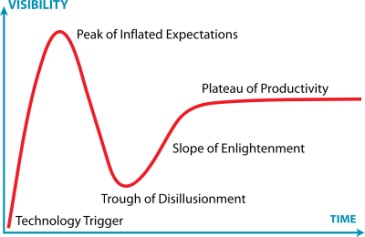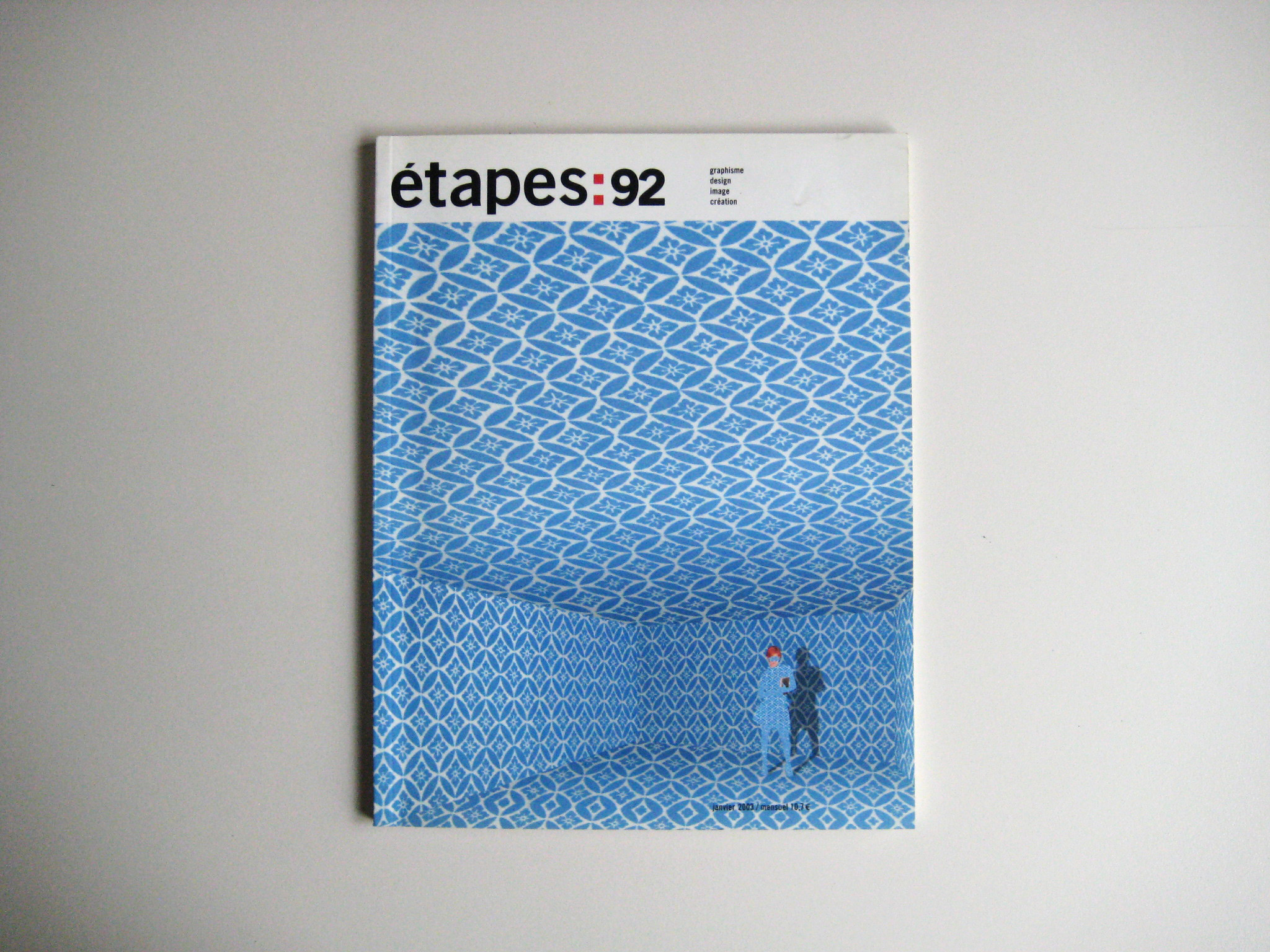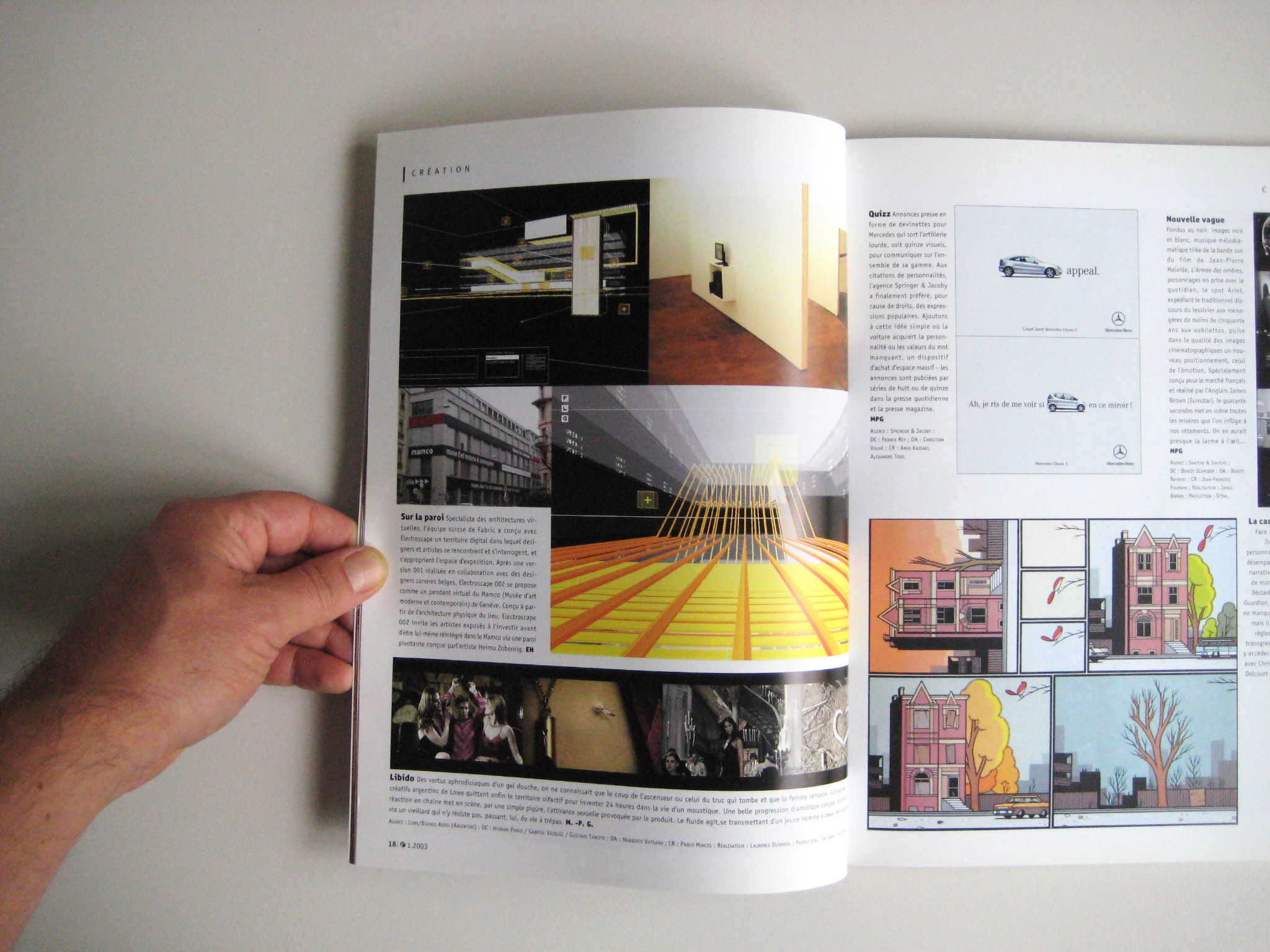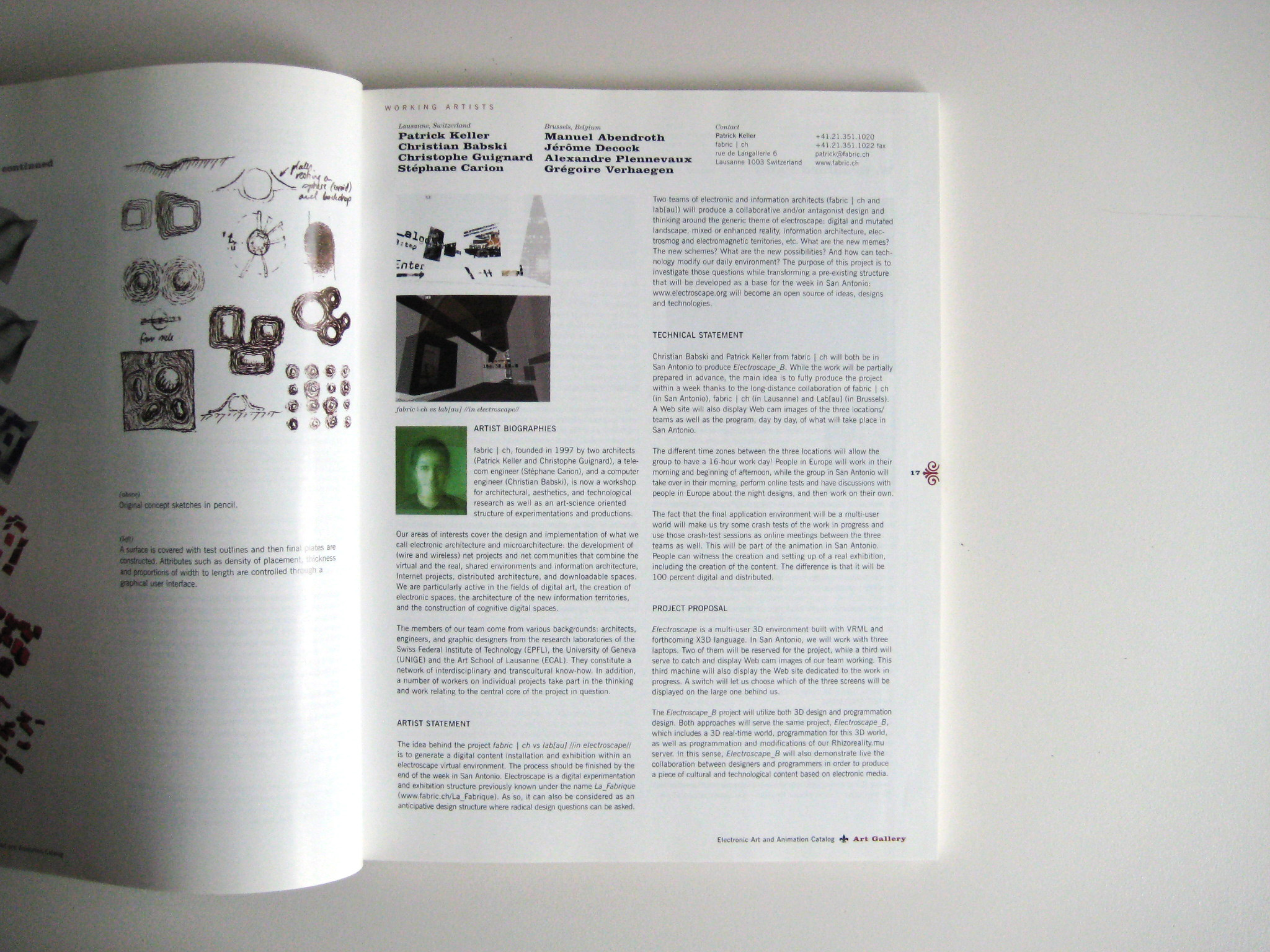Tuesday, February 15. 2011
More on Online Museums
Via Michelle Kasprzak via @chrstphggnrd
-----
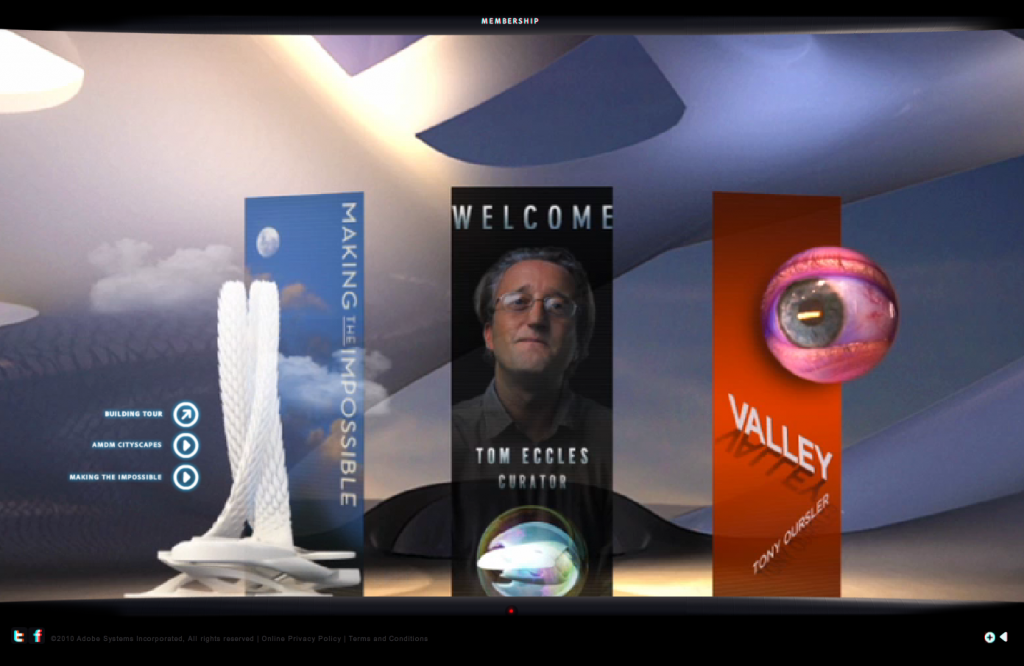
Adobe Museum of Digital Media
Rhizome recently published a piece I wrote entitled “Moving the Museum Online“. The piece was a critique of the Adobe Museum of Digital Media, and also served as a platform to discuss the concept of online museums, and highlight a few examples that I thought were particularly noteworthy, including the Virtual Museums of Canada, the Museum of Online Museums, the MINI Museum, and Google’s recent Art Project.
In both the comments section on the piece and through Twitter comments and emails, people have kindly been pointing out other examples of online museums that are of interest. Here are three that stood out:
Guggenheim Virtual Museum (vintage: 2001): “The Solomon R. Guggenheim Museum has commissioned the New York firm Asymptote Architects to design and implement a new Guggenheim Museum in cyberspace. This is the first phase of a three-year initiative to construct an entirely new museum facility. The structure will be an ongoing work in process, with new sections added as older sections are renovated. The project will consist of navigable three-dimensional spatial entities accessible on the Internet as well as real-time interactive components installed at the various Guggenheim locations.
As envisioned by Asymptote and the Guggenheim, the Guggenheim Virtual Museum will emerge from the fusion of information space, art, commerce, and architecture to become the first important virtual building of the 21st century.”
muSIEum (vintage: unknown, pre-2009): This online reconfiguration of four Viennese museums “…displaying gender, criticizing the conventional hegemonial ordering of things”, and “bringing out the different storylines that could (have) been told with the same objects from a standpoint counter-acting the cultural hegemony of the patriarchal view”. An intervention that is needed not just in Vienna, I’d wager. In German only.
MIX-m (vintage: 2001 – 2003): “MIX-m stands for MIXed-museum. It is a contemporary art museum that exists both in physical and digital spaces, in localized and networked environments. MIX-m plays with the dimensions of its architecture: a mix between a real museum space (here, the Bâtiment d’Art Contemporain in Geneva) (1:1), a digital space based on the dimensions of its host (1:x) and a model of this game-like environment (1:50). MIX-m has the ability to re-locate itself into this existing exhibition environment, transforming, mixing and extending it into new territories. It offers therefore a variable environment to create art installations. These works, commissioned by MIX-m, can now define and modulate their presence inside an extended space spectrum: physical-digital, real-simulated, localized-networked.”
Read Moving the Museum Online on Rhizome, and join the discussion there or send me a Tweet (@mkasprzak) with your own suggestions of other virtual museum projects that exemplify either the lack in current physical museums (as muSIEum does), an additionality (as with the Guggenheim), or a hybrid space (MIX-m).
Related Links:
Monday, October 25. 2010
Whatever Happened to ... Virtual Reality?

The early 90's were awesome. Bill Watterson was still drawing Calvin and Hobbes, the tattered remnants of the Cold War were falling down around our ears, and most of Wall Street was convinced the Macintosh was a computer for effete graphic designers and Apple was more or less on its way out.
Into this time of innocence came a radical vision of the future, epitomized by the movie Lawnmower Man. It was a future in which Hollywood starlets had virtual intercourse with developmentally challenged computer geeks in Tron-style bodysuits and everything looked like it was rendered by a Commodore Amiga.
Anyway, at that time Virtual Reality was a Big Deal. Jaron Lanier, the computer scientist most closely associated with the idea, was bouncing from one important position to another, developing virtual worlds with head mounted displays and, later, heading up the National Tele-immersion initiative, "a coalition of research universities studying advanced applications for Internet 2," whatever the heck that was.
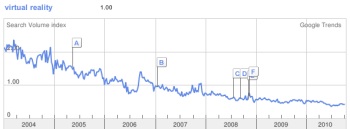 |
Even so, some sensed that the technology wasn't bringing about the revolution that had been promised. In a 1993 column for Wired that earns a 9 out of 10 for hilarity and a 2 out of 10 for accuracy, Nicholas Negroponte, founder of the MIT Media Lab (who I'm praying will have a sense of humor about this) asked the question that was on everyone's mind: Virtual Reality: Oxymoron or Pleonasm?
It didn't matter if anyone knew what he was talking about, because time has proved most of it to be nonsense:
"The argument will be made that head-mounted displays are not acceptable because people feel silly wearing them. The same was once said about stereo headphones. If Sony's Akio Morita had not insisted on marketing the damn things, we might not have the Walkman today. I expect that within the next five years more than one in ten people will wear head-mounted computer displays while traveling in buses, trains, and planes.... One company, whose name I am obliged to omit, will soon introduce a VR display system with a parts cost of less than US$25."
Affordable VR headsets were just around the corner, really? And the only real barrier to adoption, according to Negroponte? Lag. Computers in 1993 just weren't fast enough to react in real time when a user turned his or her head, breaking the illusion of the virtual.
According to Moore's Law, we've gone through something like 10 doublings of computer power since 1993, so computers should be about a thousand times as powerful as they were when this piece was written - not to mention the advances in massively parallel graphics processing brought about by the widespread adoption of GPUs, and we're still not there.
So what was it, really, that kept us from getting to Virtual Reality?
For one thing, we moved the goal posts - now it's all about augmented reality, in which the virtual is laid over the real. Now you have a whole new set of problems - how do you make the virtual line up perfectly with the real when your head has six degrees of freedom and you're outside where there aren't many spatial referents for your computer to latch onto?
And most important of all, how do you develop screens tiny enough to present the same resolution as a large computer monitor, but in something like 1/400th the space? This is exactly the problem that has plagued the industry leader in display headsets, Vuzix. Their products are fine for watching movies, but don't try using them as a monitor replacement.
Consumer-level Virtual Reality, it turns out, is really, really hard - not quite Artificial Intelligence hard, but so much harder than anyone expected that people just aren't excited anymore. The Trough of Disillusionment on this technology is deep and long.
That doesn't mean Virtual Reality is gone forever - remember how many false starts touch computing had before technologists succeeded with, of all things, a phone?
And, just a coda, even though the public long ago gave up on searching for Virtual Reality, the news media never got tired of it. Which just shows you how totally out of touch we can be:

Monday, November 17. 2008
ExitReality - Le vieux "rêve" du web en 3d
Une autre version /produit du web en 3d, ici avec construction automatique de mondes/chambres à partir de pages web (le fonctionnement est assez similaire à Knowscape (! même très!): une page dédiée d'où on load les pages). Les liens fonctionnent et le système additionne en plus tout le reste de l'attirail des mondes en 3d (chambres, avatars, îles désertes, import d'objets, etc...), les design étant assez horrible et prévisible.
ExitReality: http://www.exitreality.com
-
Ex. sur le site de fabric | ch.
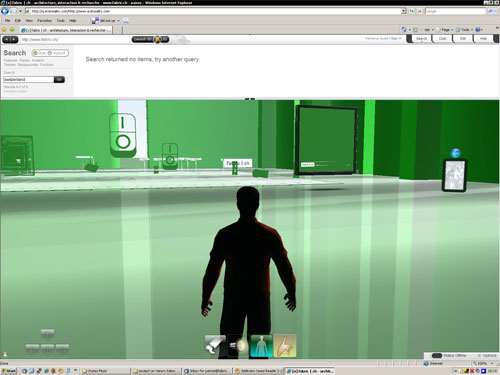
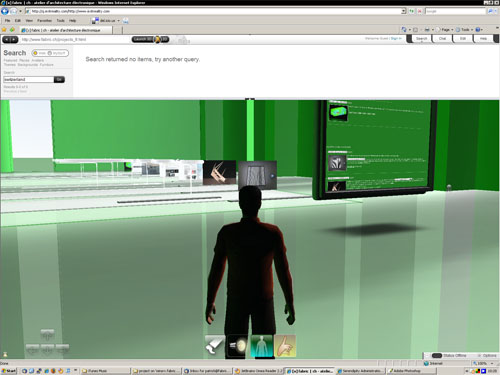
Wednesday, October 15. 2008
More Street View Imagery for France in Google Earth/Maps
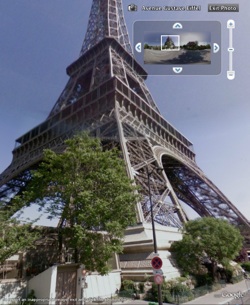 As reported at Google Maps Mania, Google has released new Street View imagery in France. Google had already released Street View imagery in July for the Tour de France. Now they have more complete coverage for the following cities: Paris, Toulouse, Lyon, Marseille, Nice, and Lille. Most people are aware you can view the Street View imagery in Google Maps, but you can also see these new spherical panoramic photos inside Google Earth with a 3D interface.
As reported at Google Maps Mania, Google has released new Street View imagery in France. Google had already released Street View imagery in July for the Tour de France. Now they have more complete coverage for the following cities: Paris, Toulouse, Lyon, Marseille, Nice, and Lille. Most people are aware you can view the Street View imagery in Google Maps, but you can also see these new spherical panoramic photos inside Google Earth with a 3D interface.
To see the images in Google Earth, turn on the Street View layer and zoom in a bit to see the camera icons over France. You can fly to a city covered with the Street View icons to find an interesting site. Then click on a camera icon near your desired location. Click "Show Full Screen" or double click the icon to enter the Photo Viewer mode. This mode lets you look in all directions using the mouse or keyboard arrows. You can also zoom in and out with the mousewheel. See a video demonstration of the Google Earth Street View imagery.
-
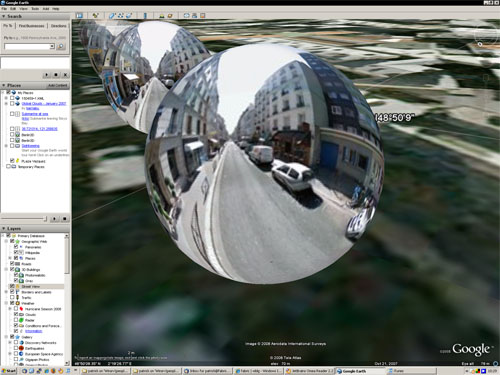
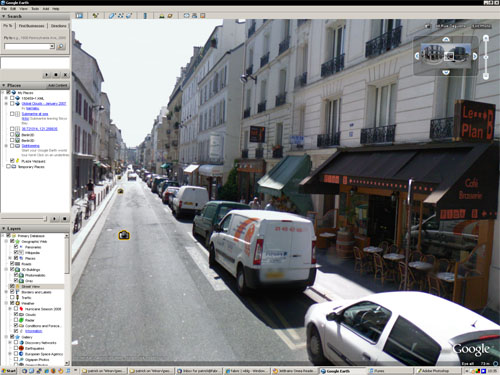
Personal comment:
Je n'avais pour ma part pas encore vu "street view" dans Google Earth et ça reste quand même assez impressionnant tout ce travail de mapping. Assez "Sysiphien"! - En s'approchant des icones d'images, vous verrez les "boules" de type Quicktime VR apparaître (la rue Daguerre et Plan B- Paris, dans l'image du bas). Double "click" sur la boule et vous entrez dans l'image puis possibilité de naviguer d'image en image (une images tous les 10m environ...). -- La vue de GE avec les boules fait d'ailleurs un peu penser à des vues dans l'env. digital de Brillantmont où il y avait ces sortes de "carrés" d'immersion dans le campus de BM.
Friday, October 10. 2008
Sony, Microsoft virtual communities to start
By Associated Press
-
CHIBA, Japan (AP) _ Video game rivals Sony and Microsoft are going head-to-head in virtual worlds for their home consoles later this year.
Both companies announced their services, which use graphic images that represent players called "avatars," Thursday at the Tokyo Game Show.
Sony Corp.'s twice delayed online "Home" virtual world for the PlayStation 3 console will be available sometime later this year, while U.S. software maker Microsoft Corp., which competes with its Xbox 360, is starting "New Xbox Experience" worldwide Nov. 19.
Microsoft's service will be adapted to various nations, but people will be able to communicate with other Xbox 360 users around the world, according to the Redmond, Washington-based company.
The real-time interactive computer-graphic worlds are similar to Linden Lab's "Second Life," which can be played on personal computers and has drawn millions of people.
In the so-called "metaverse" in cyberspace, players manipulate digital images called "avatars" that represent themselves, engaging in relationships, social gatherings and businesses.
Internet search leader Google Inc. has unveiled a similar three-dimensional software service called "Lively." Japanese companies have also set up such communities for personal computers.
Ryoji Akagawa, a producer at Sony Computer Entertainment Inc., Sony's gaming unit, said 24 game designing companies will provide content for "Home."
He did not give a launch date or other details. A limited test version over the summer was handy in preparing for a full-fledged service, he said.
In both Sony's and Microsoft's virtual worlds, players can personalize their avatars, choosing hairstyles, facial features and clothing. Akagawa said avatars will be able to dress up like heroes in hit video games.
"The Home has beautiful imagery with high quality three-dimensional graphics," he told reporters.
But Hirokazu Hamamura, a game expert and head of Japanese publisher Enterbrain Inc., who was at the Sony booth, said he needs to see more to assess "Home."
"You still can't tell what it's all about," he told The Associated Press, adding that "Home" may be coming a little late compared to rivals. "There are so many more possibilities for a virtual community."
Schappert said Microsoft's service promises to be more varied as a gateway to various entertainment, such as watching movies, going to virtual parties and sharing your collection of photos.
"Our goal is to make the Xbox experience more visual, easier to use, more fun to use and more social," he said in an interview at a nearby hotel. "We focused a lot on friends and other experiences outside just playing games."
Personal comment:
C'est la même idée qui vient et revient encore depuis 10 ans (un monde partagé en 3d, "réaliste" voire banal et quotidien, on y crée ou customize son avatar et sa maison, on y "discute", etc.). Je me demande si elle finira par prendre et décoller... ou si il s'agit simplement d'une mauvaise idée, de quelquechose qui n'intéresse pas les "users".
Friday, August 15. 2008
Marc Owens avatar termination
(...)
Another of Owens' projects, Sabre & Mace - Second Death, was concerned more specifically with the online environment Second Life.
Collaborating with Tony Mullin, he created SABRE & MACE, a company that offers virtual characters the opportunity to experience death as a way to close their user account permanently. The project examines the notion of feeling sentimental toward a virtual character and examines the link between sentimentality and tangibility.
While researching the project, the designers discovered that a great deal of second life residents have multiple avatars, some stay in favour for a long time while others loose their interest. One guy who they spoke to had 14. He said that he used a many of them as platforms for different sides of his real life personality, and for others he invented entirely new fantasy personalities. However he admitted that some of his created avatars had fallen by the wayside and he no longer used them.
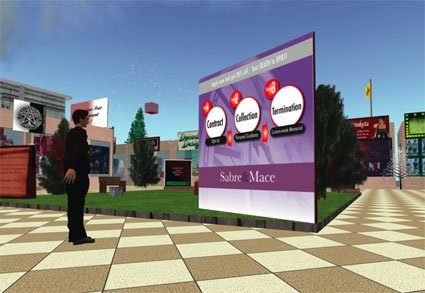
The service works as follows: Having discovered the Sabre&Mace site on-line (unfortunately the website had to be taken down after the show) or through one of the virtual adverts in Second Life, the prospective customer teleports to the company headquarters.
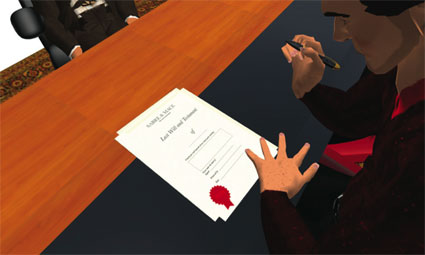
There, the client meets a manager who explains the full process and guides him or her through the signing of two contacts. Contract 1 - states that at some point (completely random) in their second life the avatar will be collected by a Sabre & Mace officer and taken back to the headquarters for termination.
Contract 2 is in fact the client's 'Last will and Testament' where he or she outlines how they wish their virtual moneys, land and assests to be distributed once they have been terminated.
The client continues to live their second life until one day, a Sabre & Mace officer appears and informs them that the final proceedings are about to begin. The client is collected and taken to the Sabre & Mace HQ.
The client meets again with the client manager, to discuss the final process. At this point the client reveals their 'account password', which is the means by which the avatar is terminated.
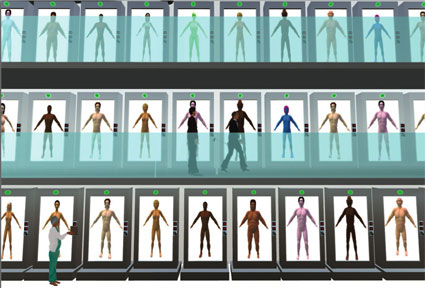
The client is led through the cryogenic chamber, where the virtual physical forms of past clients are stored. Upon arrival at the 'Termination Room', the client is instructed to walk through the 'white noise' door. Once he crosses the threshold of the door his Second Life game crashes, giving a Sabre & Mace member of staff time to change the clients password - effectively terminating the character.
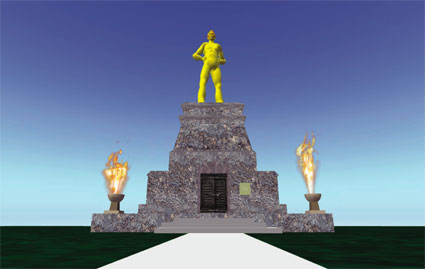
The client's former avatar is immortalised as a golden statue. Information about the avatar can be read on the plaque which sits on the monument. Should the client visit the Sabre & Mace memorial gardens he would see his own statue as well as the monuments of previous clients.
Images courtesy of Marc Owens (except the shot of his works at the RCA show.)
Related stories: Mourning and digital culture.
Related Links:
Tuesday, July 15. 2008
Google Lively - 3d fantasy virtual worlds
From Google Earth Blog:
-
Yesterday, Google let loose their newest beta product: Lively. Lively is a 3D virtual world social networking site similar in some ways to Second Life. This was first rumored to be in the works last September (see some of my thoughts on the rumor). With Lively you have to install a plugin and a separate 3D application (currently only on Windows - and it supports only IE and Firefox). It doesn't surprise me the application is not based on Google Earth. Lively is intended to allow you to enter fantasy worlds. Google Earth is intended to mirror the real world. Lively has a more cartoon-like feel which is intended to be fun and unreal - and Lively is intended to allow you to interact socially with other people over the Internet. Here's their introductory video:
On the surface, the biggest difference compared to Second Life is that instead of a single connected virtual world, you instead get a multitude of small "rooms" which anyone can set up themselves. You can create your own avatars, and dress them up with different outfits. You can also make your own rooms and add objects to them. You have controls for moving your avatar around and lots of animated actions (complete with sounds) letting you "clap", "bow", "sit", "dance", "kick", "hug", "kiss", etc. And, of course you can chat with other people in the room. This is a new application, so they haven't yet introduced APIs and scripts so you can create your own clothing and animations. But, you can expect that to happen as it evolves.
I do see a need to map locations for rooms to help people understand the locality of people who might be in the room. Some of the rooms have context of location, and then there's the issue of people speaking different languages in a room. In fact, Keir Clark at GoogleMapsMania has already produced a Google Maps mashup called Lively Map with placemarks of a few rooms. With Google Maps you can actually open a Lively room inside the placemark windows. Unfortunately, the Lively embed feature requires an <iframe> which means you can't open one in a Google Earth placemark. [UPDATE: Actually, it's probably a good thing as you shouldn't keep Google Earth open at the same time you're running Lively since they both require lots of memory (both OS and Graphics memory).] I've created a couple of Google Earth placemarks where you can at least see the locations of Lively rooms ![]() and enter them.
and enter them.
If you are into 3D virtual worlds, you should definitely give Lively a try. You have to have a Google account to set it up and use it. But, you can change your "name" in the worlds to whatever you want. I was surprised to find someone had already taken "Gearthblog" when I went to use it. Identity theft already? There's also a lot of kissing, kicking and hitting going on. But, hey, that's nothing new.
I wonder if Lively would support SketchUp files?
Monday, February 06. 2006
"Création: Electroscape 002", étapes:92 (Paris, 2003) | #digital #exhibition #web
"Version B – Electroscape 002", Attitudes – Le journal n°9 (Genève, 2002)
Saturday, February 04. 2006
"Working Artists: fabric | ch & Lab-au", Siggraph Electronic Art & Animation Catalog, ACM Siggraph (San Antonio, 2002
fabric | rblg
This blog is the survey website of fabric | ch - studio for architecture, interaction and research.
We curate and reblog articles, researches, writings, exhibitions and projects that we notice and find interesting during our everyday practice and readings.
Most articles concern the intertwined fields of architecture, territory, art, interaction design, thinking and science. From time to time, we also publish documentation about our own work and research, immersed among these related resources and inspirations.
This website is used by fabric | ch as archive, references and resources. It is shared with all those interested in the same topics as we are, in the hope that they will also find valuable references and content in it.
Quicksearch
Categories
Calendar
|
|
July '25 | |||||
| Mon | Tue | Wed | Thu | Fri | Sat | Sun |
| 1 | 2 | 3 | 4 | 5 | 6 | |
| 7 | 8 | 9 | 10 | 11 | 12 | 13 |
| 14 | 15 | 16 | 17 | 18 | 19 | 20 |
| 21 | 22 | 23 | 24 | 25 | 26 | 27 |
| 28 | 29 | 30 | 31 | |||
